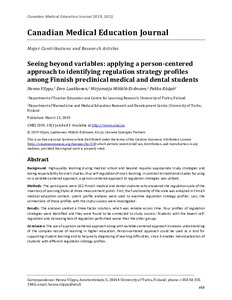Seeing beyond variables: applying a person-centered approach to identifying regulation strategy profiles among Finnish preclinical medical and dental students
Mikkilä-Erdmann Mirjamaija; Kääpä Pekka; Laakkonen Eero; Vilppu Henna
https://urn.fi/URN:NBN:fi-fe2021042827083
Tiivistelmä
learning during medical school and beyond requires appropriate study strategies
and taking responsibility for one’s studies, thus self-regulation of one’s
learning. In contrast to traditional studies focusing on a variable-centered
approach, a person-centered approach to regulation strategies was utilized.
Methods: The
participants were 162 Finnish medical and dental students who answered the
regulation scale of the Inventory of Learning Styles at three measurement
points. First, the functionality of the scale was analyzed in Finnish medical
education context. Latent profile analyses were used to examine regulation
strategy profiles. Last, the connections of these profiles with the study
success were investigated.
Results: The
analyses yielded a three-factor solution, which was reliable across time. Four
profiles of regulation strategies were identified and they were found to be
connected to study success: Students with the lowest self-regulation and
increasing lack of regulation performed worse than the other groups.
Conclusions: The use
of a person-centered approach along with variable-centered approach increases
understanding of the complex nature of learning in higher education. Person-centered
approach could be used as a tool for supporting student learning and to help
early diagnosing of learning difficulties, since it enables individualization
of students with different regulation strategy profiles.
Kokoelmat
- Rinnakkaistallenteet [19207]
